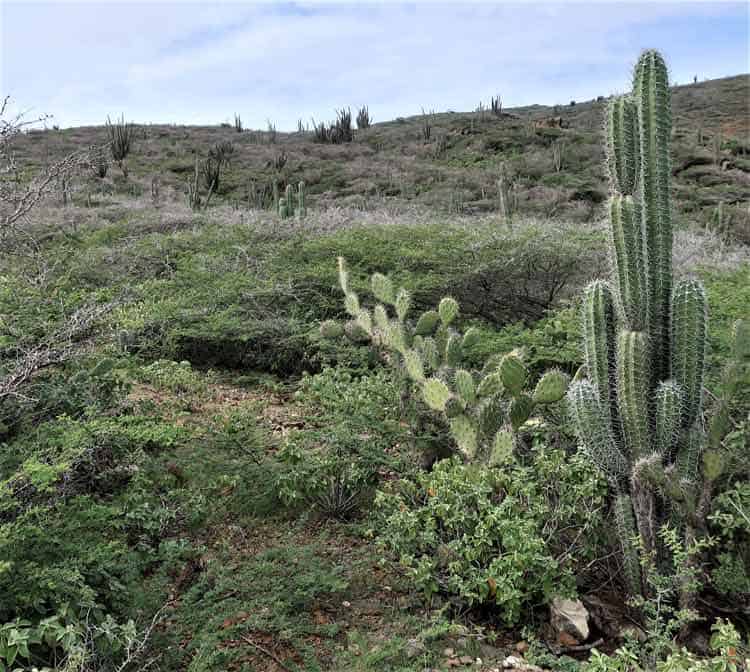
If you like to loll on magnificent beaches, visit Aruba. When seeking immersion in a fascinating multi-racial culture, think Aruba.
Want to combine a long list of activities with an other-worldly moonscape setting? Yes, Aruba.
This tiny Caribbean island more than makes up in appeal what it lacks in size.
Many people go there for the beaches, long stretches of white sand shaded by towering palm trees. They’re rated high among those throughout the world.
The water which laps them ranges in color from turquoise to deep blue, and serves as the playground for a long list of activities. Jet skis and motorboats zip back and forth offshore. Sailboats catch the breeze and excursion vessels offer ersatz pirate cruises and other seaborne experiences.
Aruba’s Interior Offers a Desert-like Setting
Inland, the scenery changes dramatically. There, Aruba presents an arid extraterrestrial landscape of rock-strewn desert pocked by towering cactus. Some goats graze in fenced fields while not far away their cousins roam free.

Many visitors spend much of their time at seaside resorts, but the island’s interior — what my wife Fyllis and I call the real Aruba – offers much to enjoy.
Our introduction to the long list of places to visit began at the Aloe Museum and Factory. After watching men use machetes to cut aloe plants growing in fields around the museum building, we were surprised to learn about the many ways they’re used in medicines and cosmetics.
History and Bird-Watching in Arikok National Park
Ancient chapters of Aruba’s past come alive in Arikok National Park, an ecological preserve that sprawls over nearly one-fifth of the island. The park attracts some of the 230-plus species of birds that reside on Aruba, or pass through during their migratory journeys to North and South America.
Ancient caves dotted about Arikok recall the time when Indians lived in Aruba. Crude brownish-red drawings that they made on the walls and ceilings are said to date back to about 1000 BC.

The Arawaks were on Aruba when the Spanish claimed it in 1499. Great Britain and Holland later gained control and it has remained a relative of the Netherlands for most of the time since 1636.
This background, and close proximity to South America, account for the melting pot of people who make up Aruba’s population. Many of them speak some English, and that — along with the island’s reputation as welcoming and safe for visitors — helps to explain its popularity among Americans. The locals truly exemplify the motto, “One happy island.”
Oranjestad, Aruba’s Capital, is rich with Dutch Culture

The capital of Aruba is Oranjestad (locals say orahn-yuh-staad), a low-rise setting over which towering cruise ships loom when they’re in port. Some of the hotels, restaurants and shops display the whimsical shapes and subtle pastel colors of Dutch colonial architecture. Other hints of the island’s connection with that country include signs in Dutch identifying the names of streets and items on the menus of restaurants that would be at home in the Netherlands.
[Insert photo: Street sign in Dutch] Names of streets are among hints of the Dutch influence on Aruba Photo by Victor Block
The oldest structure on Aruba is Fort Zoutman, which was built in 1796-1798 to ward off pirates. A turret was added later to serve as a lighthouse.

Another landmark is the Old Windmill (De Oude Molen), which was built in the Netherlands in 1804 and used to drain water from that country’s lowlands and to grind grain. After suffering damage from storms, the windmill was disassembled, shipped to Aruba and reassembled.

A good way to take in many of the sites in Aruba is to join a guided excursion. De Palm Tours is the proverbial king of the island in terms of variety and quality. Its offerings range from trips in comfortable buses to self-drive off-road outings, and from catamaran snorkeling itineraries to sunset sails.
The company even has its own island which offers a water park, banana boat rides, guided snorkeling tours and beaches. Some unusual add-on water activities round out the selection,
Whether enjoying close-up encounters with fish, exploring a diverse and different landscape or delving into an enticing history and multicultural lifestyle, the choices leave visitors wondering how so many alternatives share such a small plot of land.
If you go.
While January through March is the peak visitation period, the weather in Aruba doesn’t vary much throughout the year. Fall and early winter are the rainy seasons but that usually means a shower that stops after a few minutes
Accommodations run the gamut from high-rise hotels and small luxury resorts to all-inclusive properties and villas.
If the culture of destinations may be experienced when dining at restaurants, that certainly applies to Aruba. Along with fresh-from-the-sea fish, many menu items merge Caribbean, Dutch, South American and international cuisine with local touches. Dining often is outdoors and portions are large, so Fyllis and I usually shared an entrée.
For more information check out Aruba online.
- Broward County, Florida: When the Winter Sun Hides Behind a Cloud - April 16, 2024
- Nature is Neat in Broward County, Florida - April 1, 2024
- Margaritaville: A Time-Honored Memorial to Jimmy Buffett - March 15, 2024

